At our busiest time in May, during the peak of spring migration, Maine Audubon holds its annual Bird-a-thon. This is a fundraiser where teams of birders try to see as many species as they can within 24-hours, staying in Maine. There are strict rules for those who want to set a ‘big-day’ record, but our goal was to have fun and see what a great diversity of birds Maine has to offer.
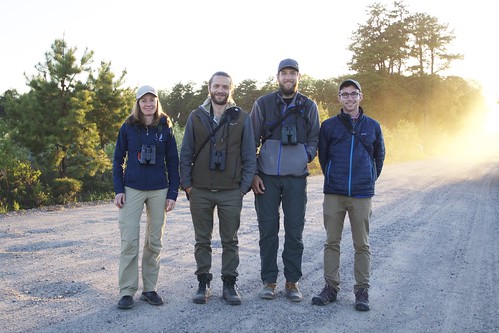
This year I had the pleasure of birding with a new team: (photo above, left to right) Lena Moser, Ian Carlson, Seth Davis, and myself. We covered a good swath of the southern and western third of the state, traveling a little over 400 miles, and saw a ton of birds while raising money for environmental education along the way.
THANK YOU so much to everyone who donated to our fundraiser or offered support along the way.
Part 1 – The Morning Haul

 Every minute counts during the Bird-a-thon and we were onsite for our first bird at 11:59PM, watching the seconds tick. Our midnight target was a stakeout King Rail that has returned to the same marsh in Wells that it frequented through the summer of 2016. The rail was incredibly close to the road but stayed just deep enough into the reeds that we couldn’t get eyes on it. Seth even brought night-vision binoculars (photo on right), but next year we’ll need x-ray vision. Which brings up a common question: Do we count birds that we only hear? The short answer is yes, as long as we are positive about who is calling. It would be convenient to sit next to a mockingbird or thrasher and count all the different species they imitate but we prefer the real thing. 😉
Every minute counts during the Bird-a-thon and we were onsite for our first bird at 11:59PM, watching the seconds tick. Our midnight target was a stakeout King Rail that has returned to the same marsh in Wells that it frequented through the summer of 2016. The rail was incredibly close to the road but stayed just deep enough into the reeds that we couldn’t get eyes on it. Seth even brought night-vision binoculars (photo on right), but next year we’ll need x-ray vision. Which brings up a common question: Do we count birds that we only hear? The short answer is yes, as long as we are positive about who is calling. It would be convenient to sit next to a mockingbird or thrasher and count all the different species they imitate but we prefer the real thing. 😉
King Rail at 12:00AM! Song Sparrow and Least Sandpiper also. Good start to #birdathon2017 pic.twitter.com/SeZGr8PAGF
— Doug Hitchcox (@dhitchcox) May 20, 2017
A few calling sandpipers, a Song Sparrow, and a little further up the road we heard Virginia Rail calling – a solid start to the day! We struck out on a few owl locations: an Eastern Screech-Owl had been heard in a York neighborhood for the last 1.5+ years, but was completely silent during our visit.
The winds overnight were out of the northwest, unfavorable for migrants, so we planned on going north and trying to get into some boreal habitat. Pointing north, we drove to Rangeley stopping Great Horned Owl and American Woodcock along the way. We made it to the Boy Scout Road in time for sunrise and the cacophony of breeding birds.

Along the Boy Scout Road we tallied 38 species, including 14 species of warbler plus a boreal specialty: Gray Jay. We had hoped for other ‘northern’ birds but we were happy to get so many neotropic migrants on their breeding territory since the coast would have been devoid of new migrants. Here is our checklist from Rangeley including audio recordings of a few species: ebird.org/ebird/view/checklist/S37033813. One thing we didn’t anticipate was how COLD it would be – there was even a frost!
A few random stops around Rangeley helped add species we’d struggle with further south, like Common Merganser, but we needed to keep moving and we were off to Belgrade…
Part 2 – Lunch Can Wait
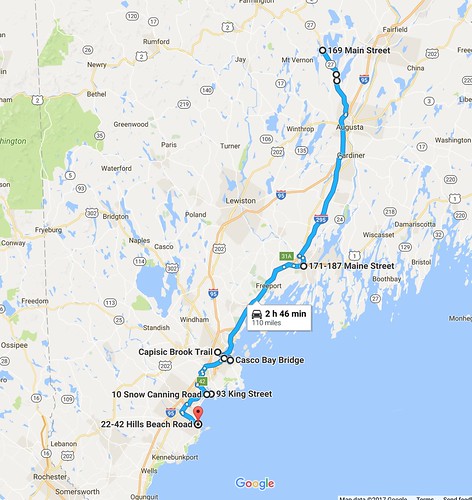
A fun part of covering so much ground during the bird-a-thon is that you get to a lot of unique habitats and the birds that specialize there. The Belgrade Lakes region, specifically around Messalonskee Lake, holds a few tough-to-get species in a very small area. The Depot Road Purple Martin colony was in full swing with 15+ birds present during our quick stop; Bank Swallows were another quick tick at the sand pits down the road.
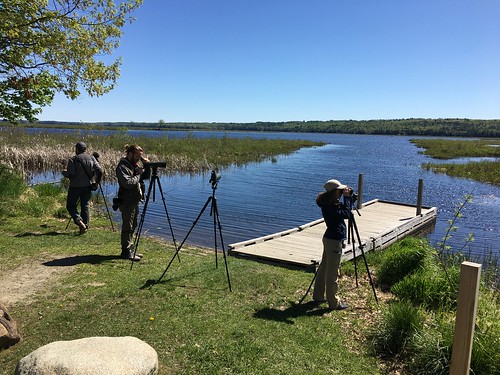
Only two Black Terns were visible (briefly) at Messalonskee, and unfortunately ZERO Sandhill Cranes could be found. Other targets like American Bittern were quiet because it was late in the morning and the wind was picking up. Despite the tough(er) conditions, the birding was fantastic – enough so that I forgot to eat the ice cream sandwich I picked up at Day’s Store (this was happily our only ‘mess’ of the day).
A quick stop in Brunswick got us Fish Crow (when it FINALLY vocalized), but we hadn’t scouted for the Merlin that nests on the Bowdoin campus – we lucked into one later in the day.
Fish Crow in proper habitat. #birdathon2017 pic.twitter.com/u4JAQOS9X0
— Doug Hitchcox (@dhitchcox) May 20, 2017
A few stops in Portland helped add new species: Capisic Pond = Orchard Orioles; Mercy Pond = Black-crowned Night Heron; unfortunately Casco Bay did NOT = Peregrine Falcon. This was our first access to the coast, though, and shorebirds at Pine Point in Scarborough did not disappoint: ebird.org/ebird/view/checklist/S37033916 (highlighted by a single alternate plumage Red Knot).
We continued south to Biddeford, using Lena and Seth’s local knowledge to pick up Wood Ducks and Eastern Bluebird on the UNE campus.
Part 3 – A Rarity Before Sunset
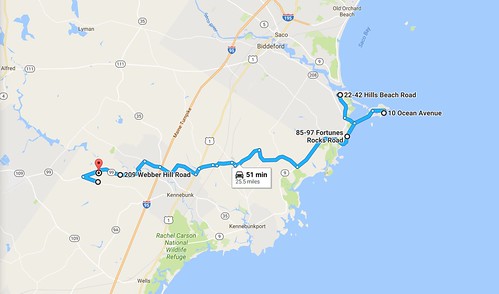
Seawatching near East Point Sanctuary at Biddeford Pool added White-winged and Black Scoters, plus Common and Roseate Terns. For the last few years, during the bird-a-thon, we’ve been treated to large movements of White-winged Scoters along the coast. This year we counted 246 streaming north during our brief stop (photo below). For comparison, here is a list from 2015 when we had ~310 scoters fly overhead while at Kennebunk Plains: http://ebird.org/ebird/view/checklist/S23625866
We swung down to Fortunes Rocks Beach following up on a Mute Swan report from earlier in the day. The swans were gone (good riddance) but Lena made the find of the day with a beautiful PACIFIC LOON foraging among several Red-throated Loons just offshore. Pacific Loons are reported almost annually in Maine but typically through the winter when they are in their [dull] basic plumage. This bird was a stunner! A little far off for good photos but the low sun angle made for a spectacular image through the scope:
What a last minute find by Lena! Pacific Loon in Biddeford!! pic.twitter.com/R3JHnvE5Hu
— Doug Hitchcox (@dhitchcox) May 21, 2017
There is one huge problem with finding a rarity during the bird-a-thon: you *shouldn’t* have time to stay and watch/photograph/appreciate it. And that is probably why we just missed our goal number for the day: we had FUN birding. We watched that Pac Loon as long as we could, salvaging the last bit of day light for our time at Kennebunk Plains. This probably cost us Clay-colored Sparrow and a few other plains specialties…but it was worth it.
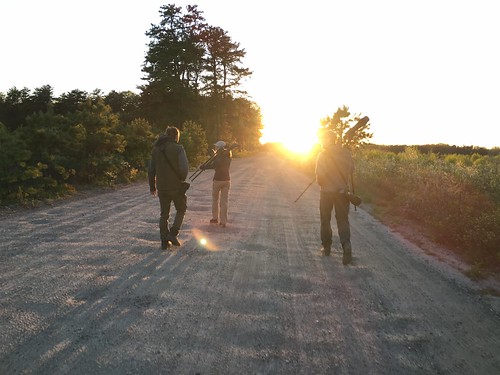
Walking into the plains at sunset is one of my highlights each year. The chorus of Eastern Whip-poor-wills is wonderful. This year Common Nighthawks were passing overhead, Grasshopper Sparrows and Upland Sandpipers continue to sing as it gets darker, and eventually a pair of Barred Owls duetted from the edge of the pond (north of the plains). While taking in all the sounds, we treated our other senses to some of Lena’s homemade guac – to the victors go the spoils!
Chips and guac while listening to Eastern Whip-poor-wills call around us. A good way to wind down a 146 species day. #birdathon2017 pic.twitter.com/iaPtvEUJkb
— Ian Carlsen (@ianalancarlsen) May 21, 2017
Results
We ended with 146 species, just shy of our 150 goal. We missed some ‘easy’ species like Wild Turkey (how?!), Piping Plover (we literally knew where every nest in the state was), Eastern Wood-Pewee (were we not paying attention?) and Hairy Woodpecker (not our first year missing this). Despite these ‘misses,’ it is amazing that our state offers so much diversity – in species, habitats, and climates – that can all be explored in a single day. Again, I cannot thank our supporters enough, and especially my teammates who made this incredibly fun day possible!
-Doug
P.S. This event is all about having fun, with a bit of competition among the teams. While I don’t want to brag, this is first year we’ve beat the other Audubon team for number of species! Go team!

